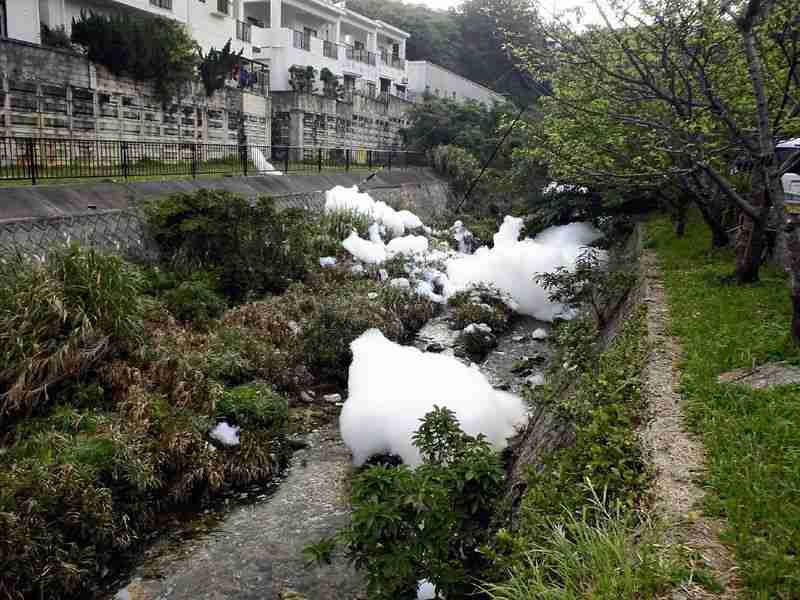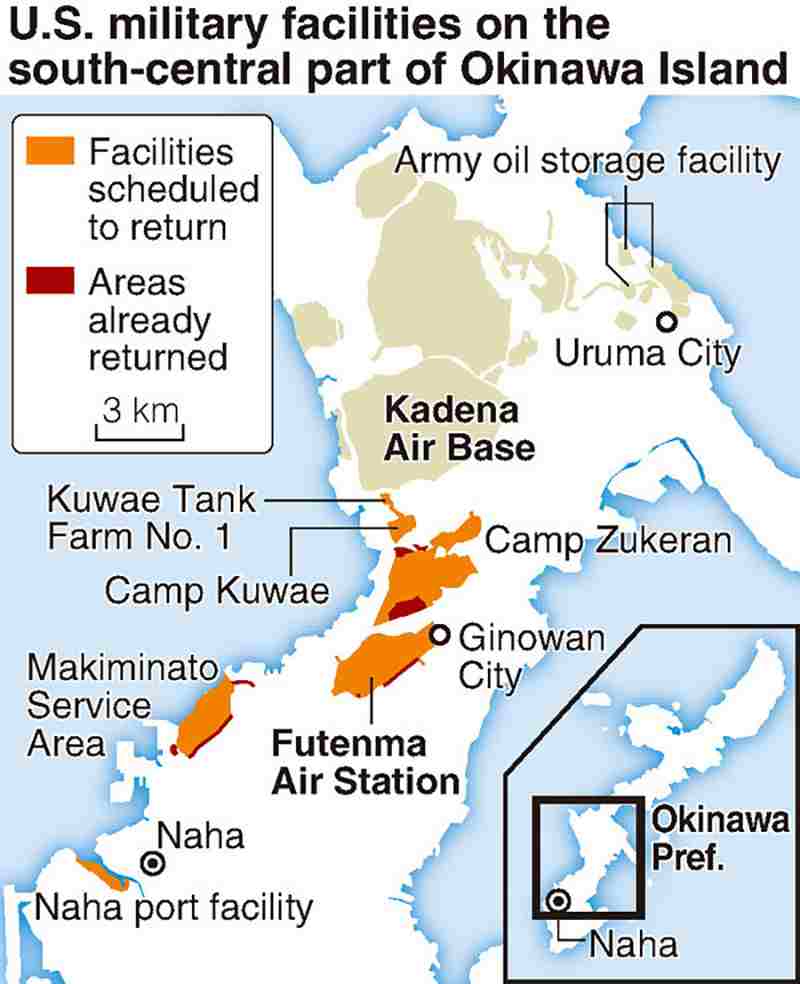Local govts in Okinawa Pref. often kept from checking U.S. bases’ environmental pollution

Chemical foam floats on a river running through a residential area in Ginowan, Okinawa Prefecture, on April 11 in 2021, following an accident in which firefighting foam leaked from Futenma Air Station.
12:03 JST, January 2, 2022
Although municipal governments in Okinawa Prefecture officially have the ability to conduct on-site inspections in cases of environmental pollution accidents on U.S. military bases, such as the release of harmful substances, the practical viability of the system has come into question.
The Agreement on Cooperation in the Field of Environmental Stewardship Supplementary to the Japan-U.S. Status of Forces Agreement, which was signed in 2015, allows concerned local governments to conduct on-site inspections if necessary.
The agreement was expected to enable local authorities to quickly learn the details of contamination conditions and demand improvements. But how to proceed with the inspections is left to the U.S. forces’ discretion.

So far, inspections have been conducted in just two cases in Okinawa Prefecture, but the procedures did not progress quickly. There were other cases in which local governments could not conduct inspections as the U.S. forces did not regard the incidents as accidents.
Chemical foam in river
On April 10, 2020, a fire-extinguisher system in a hangar at the U.S. forces’ Futenma Air Station in Ginowan accidentally discharged, and about 143,830 liters of firefighting foam flowed out of the air station through the drainage system.
A huge amount of white foam floated down a river that runs through residential areas. Some of the foam became airborne and stuck to playground equipment at a child care center.
Members of the Ginowan city fire department used buckets to remove some of the foam from the river. But because the foam continued flowing for a long time, they were left with no choice but to spray it with water to dilute it.
The firefighting foam contained substances harmful to humans, including perfluorooctane sulfonate (PFOS).
PFOS repels both water and oil, and is used in firefighting foam and water repellents. Its negative effects on health and ecosystems have been recognized internationally.
In Japan, PFOS was designated a Class 1 Specified Chemical Substance in 2010. Use of Class 1 substances is restricted, and production of them is prohibited in principle.
Kaori Tamamura, 54, principal of an elementary school beside the river, said: “We temporarily made the area around a spring on the school grounds off-limits. It could have threatened the safety of the children. This kind of accident should not occur.”
The central, prefectural and municipal governments immediately demanded the U.S. side allow an on-site inspection under the supplementary agreement. The inspection was the first to be allowed in the years since the agreement was signed.
Because pollutants are diluted day by day, a quick inspection is essential to obtain the numerical figures needed to correctly determine the level of seriousness of the pollution.
However, the inspection in the PFOS foam incident was not conducted until six days after the accident occurred. Though officials entered the accident site five times in total, the places where they could collect water and other samples were limited to those allowed by the U.S. side.
From the collected samples, numerical figures that were double the safety standard were detected. But those results could not be made public for about four months because the U.S. side had not agreed.
Depending on the figures, the Japanese officials may have been required to issue cautions to residents. Delays in disclosing such information could therefore adversely affect residents’ lives.
Small step forward
According to the Okinawa prefectural government, several cases a year of accidents related to U.S. bases, such as leaks of aircraft fuel, have occurred. But before the 2015 agreement, local officials could not inspect the accident sites unless the U.S. side decided to allow it in the name of “goodwill.”
The supplementary agreement stipulates that local governments can apply to make inspections. Though the agreement was expected to put pressure on the U.S. side to prevent the recurrence of similar cases, the agreement only lists cases that are subject to inspections by the Japanese side.
It is left to the U.S. forces’ discretion whether the requests for inspections are accepted.
In 2016, a high concentration of PFOS was detected at a water purification plant near Kadena Air Base, which sprawls through Okinawa City and neighboring municipalities.
At the time, inspection by Japanese officials was not allowed on the grounds that an accident had not occurred as specified under the agreement.
A PFOS case that happened in 2021 also demonstrated the hurdles that local inspectors face. In June 2021, water containing PFOS leaked from a U.S. Army oil storage facility in Uruma City in the prefecture.
Though an on-site inspection was allowed two days after the incident, the results of the analysis of collected samples, which was concluded in late July, were not made public for about five months.
Keijiro Yokota, head of the prefectural government’s office for measures on environmental affairs on U.S. bases, expressed his irritation, saying: “Before, we could enter accident sites only with the U.S. side’s goodwill, and so the issue surely made one step forward. Despite that, there are too many restrictions.”
Effects after return
The supplementary agreement stipulates inspections are to be conducted before the return of base land plots, in addition to at the time of accidents, but the viability of this point is also being questioned.
The prefectural government has demanded that inspections within three years before return be conducted to avoid delays in use of vacated land plots.
This kind of inspection has been carried out in five cases. From now on, land plots of six U.S. military facilities are scheduled to return to Japan in the south-central part of Okinawa Island, and negative impacts are feared if large-scale pollution is found.
Under the status of forces agreement, U.S. forces are not obliged to clean up or pay compensation, and thus there have been many cases in which contamination was found for the first time only after land was excavated following return.
In Chatan Town in 2003, lead and other pollutants were detected on some parts of returned land that had been part of Camp Kuwae. Cleanup work took a long time and thus the last lot of the land was not handed over until as late as spring of 2020.
Masaharu Noguni, 76, a former mayor of the town who served in the post for four terms totaling 16 years, said, “It is also problematic that not all of the documents showing the land’s usage history are disclosed. To prevent delays in the use of returned land plots, which will support development of Okinawa Prefecture, the agreement should be reviewed so that it will be more effective.”
"Politics" POPULAR ARTICLE
-

Japan to Support Central Asian Logistics Route That Bypasses Russia, Plan to Be Part of Upcoming Summit in Tokyo
-

Japan to Tighten Screening of Foreigners’ Residential Status by Providing Information of Nonpayment of Taxes
-

Chinese, Russian Bombers Flew Unusual Path by Heading Toward Tokyo; Move Likely Meant to Intimidate Japan
-

Japan Plans National Database to Track Foreign Ownership of Real Estate, Land as It Weighs New Rules
-

Up to 199,000 Deaths Estimated From Mega-Tsunami; Most Recent Occurrence Took Place in 17th Century
JN ACCESS RANKING
-

Keidanren Chairman Yoshinobu Tsutsui Visits Kashiwazaki-Kariwa Nuclear Power Plant; Inspects New Emergency Safety System
-

Tokyo Economic Security Forum to Hold Inaugural Meeting Amid Tense Global Environment
-

Imports of Rare Earths from China Facing Delays, May Be Caused by Deterioration of Japan-China Relations
-

University of Tokyo Professor Discusses Japanese Economic Security in Interview Ahead of Forum
-

Japan Pulls out of Vietnam Nuclear Project, Complicating Hanoi’s Power Plans
























